“In the past, traditional genetic methods have been used to compare the similarities between populations of animals, involving tens of genetic markers,” says Andrew. “Now, with modern genetic sequencing methods, we are moving the field to look at pedigrees of animals to understand individual movement.”
Investigating how target species move at a landscape scale to better understand reinvasion pathways and how to use management tools and, potentially, natural barriers to block them, will be key to meeting Aotearoa New Zealand’s attempts to eradicate mustelids, rats, and possums by 2050.

Understanding possums brings researchers closer to better management processes.
The first stages of this work have involved a series of large, site-based programmes where various combinations of pests are targeted for local elimination. Individual-based landscape genomics is a novel field and one of many strategies used to identify relationships between environmental factors and the genetic adaptation of organisms in response to these factors. Manaaki Whenua has several landscape genomics programmes underway for almost all pest mammals in Aotearoa New Zealand, which are world-leading in terms of their methods and applicability.
Studies using landscape genomics for possums in Aotearoa New Zealand include one for OSPRI (the national agency responsible for eliminating bovine TB) in Westland, one for Towards Predator Free Taranaki, and another study for Predator Free Hawke’s Bay aimed at understanding whether possums can be eliminated from a peninsula.
In the study for OSPRI, researchers used chew cards to survey possums on farmland and in forest on both sides of a river. Andrew says the possums were then captured for DNA genotyping. “We sequenced the genomes of 280 possums and calculated their pairwise relatedness, which indicated extremely high genetic differentiation between possums on each side of the river – with two exceptions. The exceptions were captured within 350 m of the only bridge within the study area, indicating they had probably crossed the river using the bridge.”
A ‘hybrid’ possum with an intermediate genotype was also captured in the same place, indicating one of its parents had probably also crossed the bridge. “We found that the river forms an almost complete barrier to possum movement, but the bridge appears to permit some movement of possums across the river,” says Andrew.
The study showed no long-distance dispersal from the deep forest, where TB is prevalent, to the farmland, leading researchers to conclude the source of TB infection to cattle in the area is probably through stepwise possum-to-possum transmission rather than long-distance dispersal.
“From these results we were able to provide OSPRI with specific management recommendations for their control programmes to minimise the spread of TB from possums to livestock in this region,” says Andrew.
On Mount Taranaki, DNA sequencing showed that wide rivers with continuous flow stopped possum reinvasions, unless there were any bridges or points of canopy closure over the river. These acted as potential invasion points that would need to have vigilant control measures concentrated on each side of the breach.
Researchers were able to supply specific maps showing areas of reinvasion risk to assist Toward Predator Free Taranaki to create zero possum density zones. “If successful, this region will be the largest area of the mainland managed for possum elimination,” says Andrew.
The dispersal story is quite different for stoats and weasels. After using landscape genomics to investigate mustelid movements on the Taranaki ring plain, researchers found that no landscape features affected stoat or weasel dispersal. They also travel long distances, sometimes, in the case of stoats, as far as 40 km. These results show that predator control needs to be maintained over large landscape scales to decrease reinvasion.
“From the genetic evidence in this study, and based on what we know about stoat biology and from other stoat eradication programmes, it appeared likely that most recruitment is from surviving residents in a control area rather than immigrants, so detecting and removing residents remains the primary concern for managers,” says Andrew.
There are many more ongoing studies in this research area, including possums on Māhia Peninsula, rats in Wellington, wallabies across the country, and stoats on Waiheke Island, in Fiordland, and in Wellington. Manaaki Whenua is creating novel methods to address these fine-scale questions of movement and aims to create a generalised system for planning such studies based on the ecology of each species.

